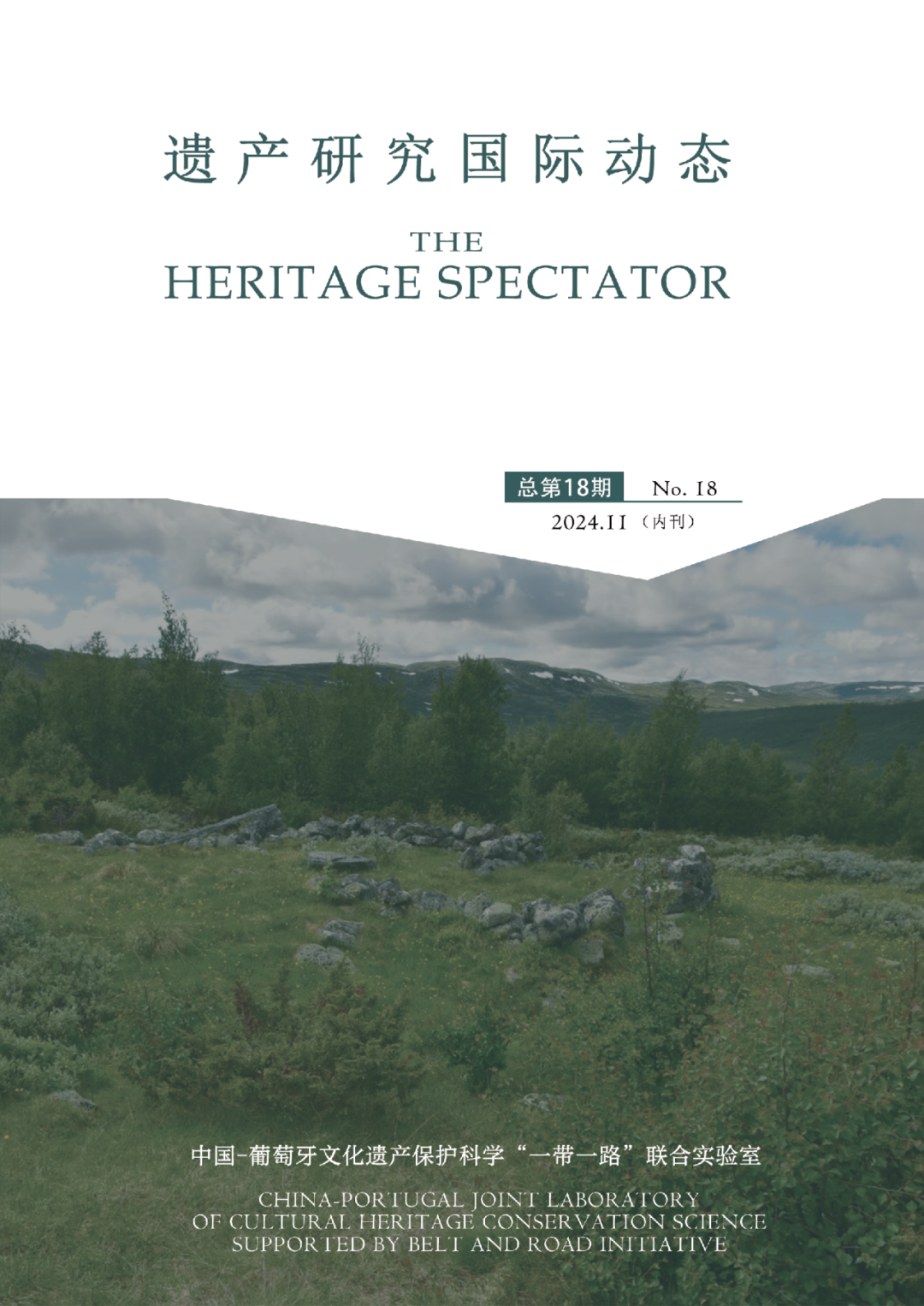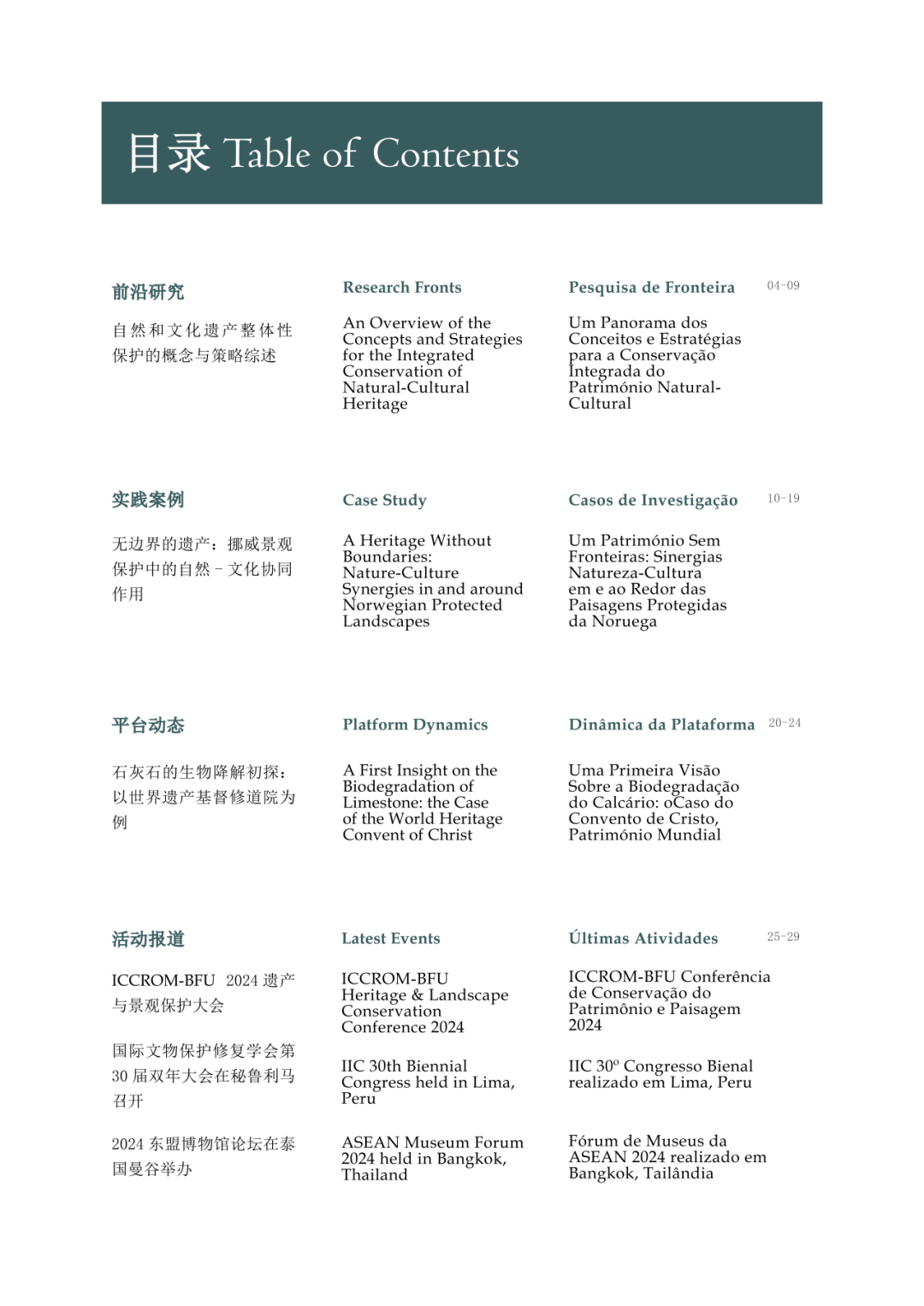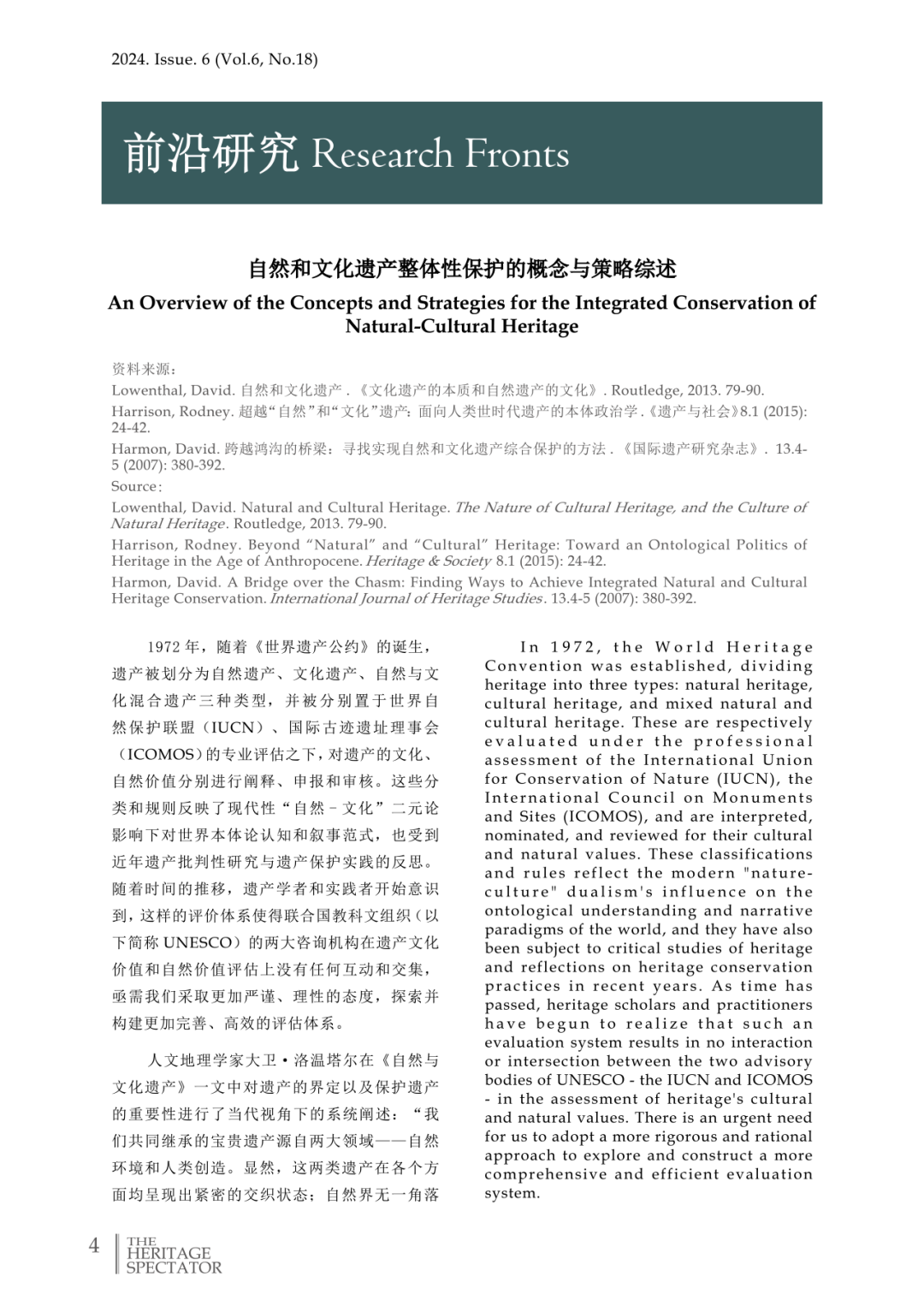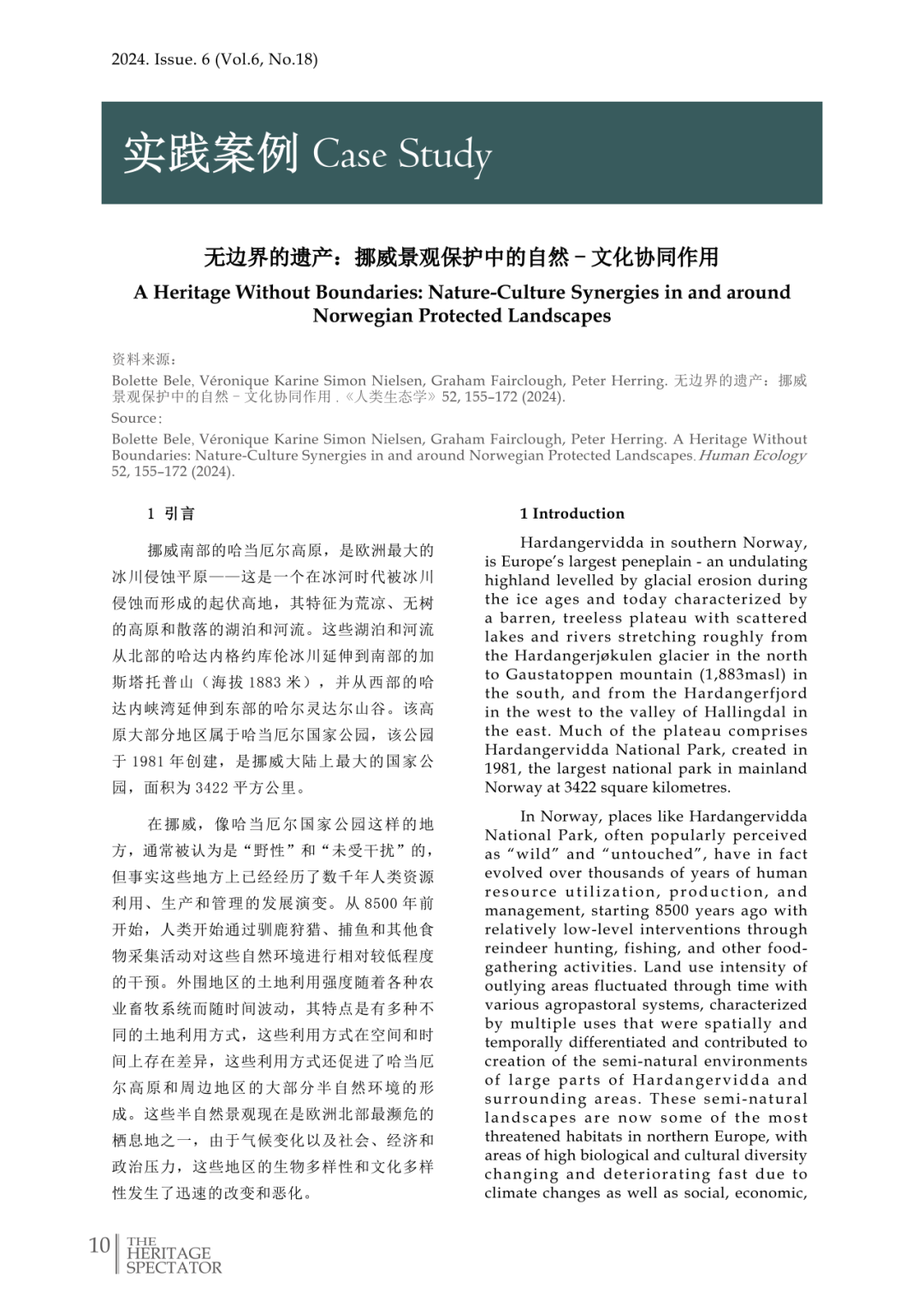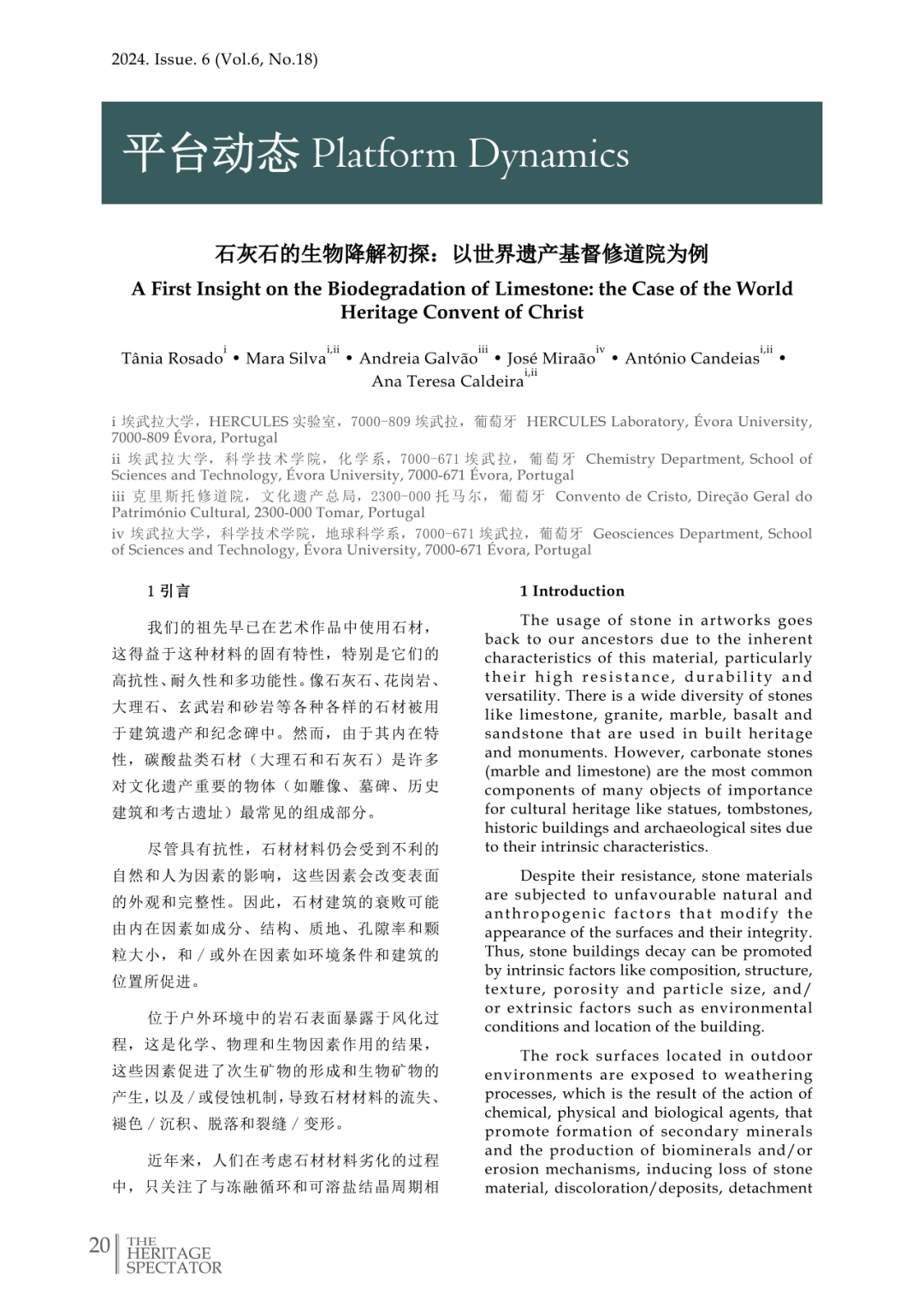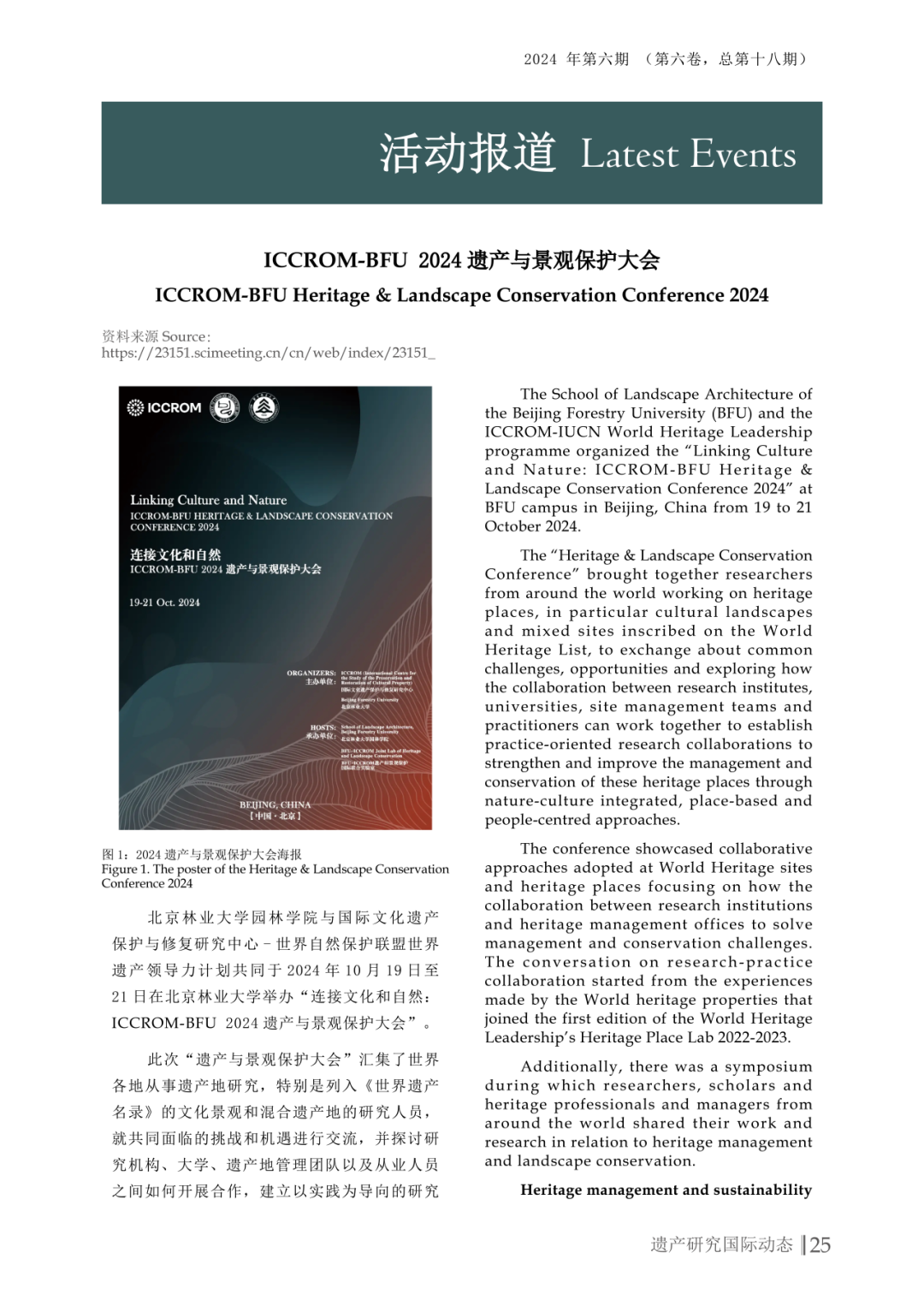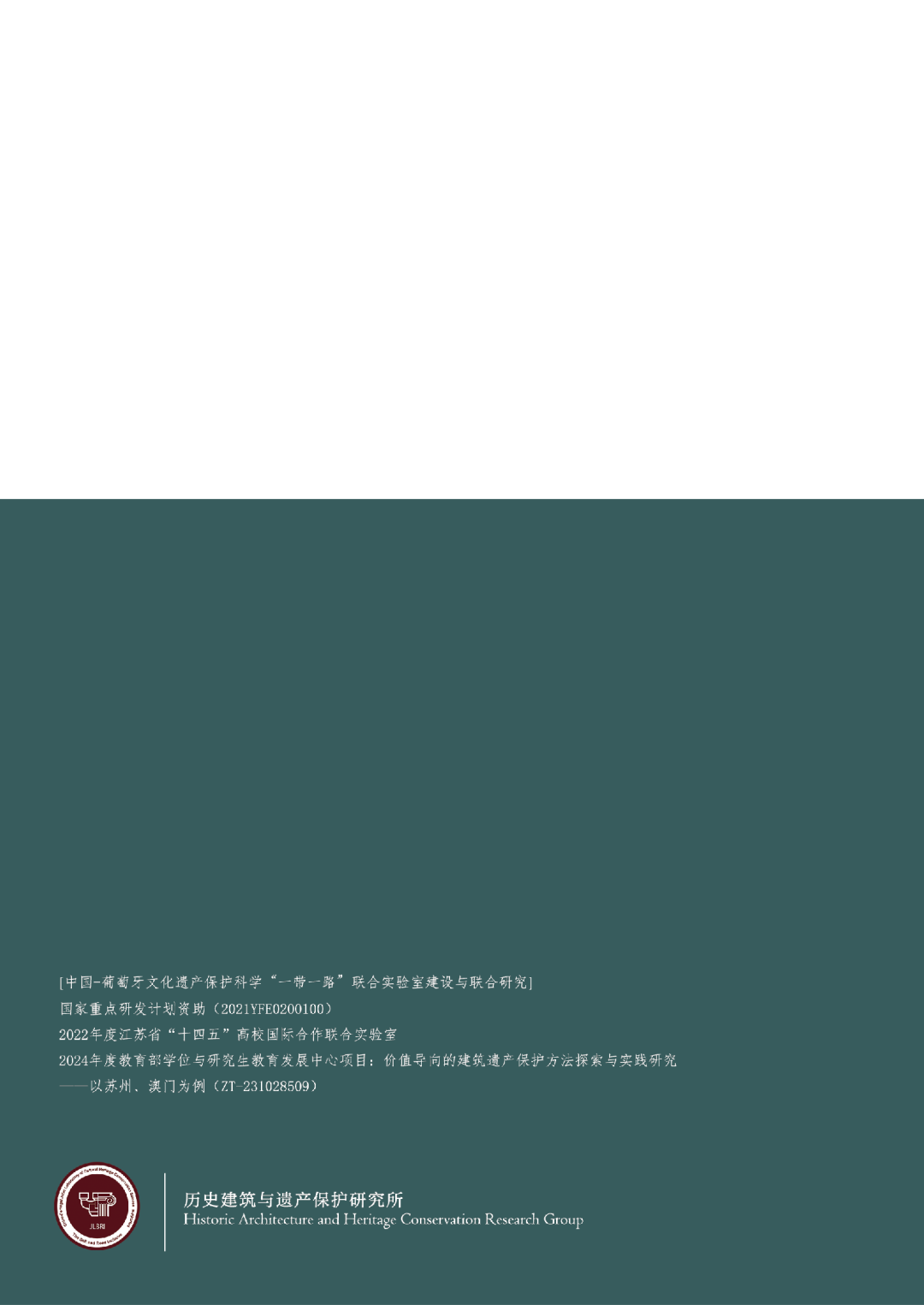联合实验室中英双语双月刊《遗产研究国际动态》(内刊)2024年第六期(总第十八期)已发布,全刊内容可在此下载
![]() JLBRI国家“一带一路“联合实验室《遗产研究国际动态》总第十八期The Heritage Spectator No.18.pdf
JLBRI国家“一带一路“联合实验室《遗产研究国际动态》总第十八期The Heritage Spectator No.18.pdf
前沿研究
自然和文化遗产整体性保护的概念与策略综述
1972年,随着《世界遗产公约》的诞生,遗产被划分为自然遗产、文化遗产、自然与文化混合遗产三种类型,并被分别置于世界自然保护联盟(IUCN)、国际古迹遗址理事会(ICOMOS)的专业评估之下,对遗产的文化、自然价值分别进行阐释、申报和审核。这些分类和规则反映了现代性“自然-文化”二元论影响下对世界本体论认知和叙事范式,也受到近年遗产批判性研究与遗产保护实践的反思。随着时间的推移,遗产学者和实践者开始意识到,这样的评价体系使得联合国教科文组织(以下简称UNESCO)的两大咨询机构在遗产文化价值和自然价值评估上没有任何互动和交集,亟需我们采取更加严谨、理性的态度,探索并构建更加完善、高效的评估体系。
人文地理学家大卫·洛温塔尔(David Lowenthal)在《自然与文化遗产》(Natural and cultural heritage)一文中中对遗产的界定以及保护遗产的重要性进行了当代视角下的系统阐述:“我们共同继承的宝贵遗产源自两大领域——自然环境和人类创造。显然,这两类遗产在各个方面均呈现出紧密的交织状态;自然界无一角落能免于人类活动的深远影响,同样,每一件人类创造的文物也无不镌刻着环境的痕迹。然而,值得注意的是,我们在传统上对于这两类遗产的处理方式却存在显著差异。尽管在管理与维护这两类遗产的过程中,存在着诸多共通之处,且两个领域经常共享相似的,乃至相同的领导者与代表,但二者之间的关系却更多地表现为一种基于嫉妒与竞争的态势,而非基于友好合作。本文详尽地探讨了自然与文化保护策略差异的根本原因,并进一步阐释了这些策略如何影响保护与保存活动。在过去半个世纪中,保护或破坏遗产的历史进程、政治斗争以及修辞表达,在某些领域呈现出融合的趋势,而在其他方面则显示出了分歧。
An Overview of the Concepts and Strategies for the Integrated Conservation of Natural-Cultural Heritage
In 1972, the World Heritage Convention was established, dividing heritage into three types: natural heritage, cultural heritage, and mixed natural and cultural heritage. These are respectively evaluated under the professional assessment of the International Union for Conservation of Nature (IUCN), the International Council on Monuments and Sites (ICOMOS), and are interpreted, nominated, and reviewed for their cultural and natural values. These classifications and rules reflect the modern nature-culture dualism's influence on the ontological understanding and narrative paradigms of the world, and they have also been subject to critical studies of heritage and reflections on heritage conservation practices in recent years. As time has passed, heritage scholars and practitioners have begun to realize that such an evaluation system results in no interaction or intersection between the two advisory bodies of UNESCO—the IUCN and ICOMOS—in the assessment of heritage's cultural and natural values. There is an urgent need for us to adopt a more rigorous and rational approach to explore and construct a more comprehensive and efficient evaluation system.
Human geographer David Lowenthal systematically expounds on the definition of heritage and the importance of preserving heritage from a contemporary perspective in his article Natural and Cultural Heritage:“We receive communal legacies from two sources—the natural environment and the creations of human beings. To be sure, these inheritances everywhere commingle; no aspect of nature is unimpacted by human agency, no artefact devoid of environmental impress. Yet we have traditionally dealt quite differently with these two kinds of legacy. Though management of both heritages has many features in common, and both realms often share similar, if not the same, leaders and spokesmen, relations between the two are marked less by cooperative amity than by envy and rivalry. This essay discusses the reasons for our dissimilar approaches to nature and culture, and shows how they bear on the campaigns to protect and preserve each. In some important ways, the history, politics, and rhetoric of conservation and destruction are shown to have converged, in others to have diverged, over the last half century.”
资料来源:
Lowenthal, David. Natural and cultural heritage. The Nature of Cultural Heritage, and the Culture of Natural Heritage. Routledge, 2013. 79-90.
Harrison, Rodney. Beyond “natural” and “cultural” heritage: Toward an ontological politics of heritage in the age of Anthropocene. Heritage & society 8.1 (2015): 24-42.
Harmon, David. A bridge over the chasm: Finding ways to achieve integrated natural and cultural heritage conservation. International Journal of Heritage Studies. 13.4-5 (2007): 380-392.
实践案例
无边界的遗产:挪威景观保护中的自然-文化协同作用
挪威南部的哈当厄尔高原,是欧洲最大的冰川侵蚀平原——这是一个在冰河时代被冰川侵蚀而形成的起伏高地,其特征为荒凉、无树的高原和散落的湖泊和河流。这些湖泊和河流从北部的哈达内格约库伦冰川延伸到南部的加斯塔托普山(海拔1883米),并从西部的哈达内峡湾延伸到东部的哈尔灵达尔山谷。该高原大部分地区属于哈当厄尔国家公园,该公园于1981年创建,是挪威大陆上最大的国家公园,面积为3422平方公里。
像哈当厄尔国家公园这样的地方,通常被认为是“野性”和“未受干扰”的,但事实这些地方上已经经历了数千年人类资源利用、生产和管理的发展演变。从8500年前开始,人类开始通过驯鹿狩猎、捕鱼和其他食物采集活动对这些自然环境进行相对较低程度的干预。外围地区的土地利用强度随着各种农业畜牧系统而随时间波动,其特点是有多种不同的土地利用方式,这些利用方式在空间和时间上存在差异,这些利用方式还促进了哈当厄尔高原和周边地区的大部分半自然环境的形成。这些半自然景观现在是欧洲北部最濒危的栖息地之一,由于气候变化以及社会、经济和政治压力,这些地区的生物多样性和文化多样性发生了迅速的改变和恶化。
研究区域位于诺尔厄-乌瓦达尔市(面积2,501平方公里,其中873平方公里位于哈当厄尔国家公园内;2023年人口2,509人)。该区域涵盖了哈当厄尔高原东部的部分地区,包括在国家公园内外的区域,可以比较受保护和未受保护区域的范围。此外,该区域拥有良好的牧场,并且是重要的文化遗产和农业活动及旅游业的重要场所。诺尔·乌瓦达尔市主要是一个农村市镇,但自1960年代以来,畜牧业系统发生了巨大变化。外场牧场上的牲畜数量在1995年至2022年间下降了34%(其中牛减少了35%,绵羊减少了33%)。而且在上世纪70年代,诺雷和乌瓦达尔市放弃了水电项目的建设,并积极致力于国家公园的建立。
A Heritage Without Boundaries: Nature‑Culture Synergies in and around Norwegian Protected Landscapes
Hardangervidda in southern Norway, is Europe’s largest peneplain—an undulating highland levelled by glacial erosion during the ice ages and today characterized by a barren, treeless plateau with scattered lakes and rivers stretching roughly from the Hardangerjøkulen glacier in the north to Gaustatoppen mountain (1,883masl) in the south, and from the Hardangerfjord in the west to the valley of Hallingdal in the east. Much of the plateau comprises Hardangervidda National Park, created in 1981, the largest national park in mainland Norway at 3422 square kilometres.
In Norway, places like Hardangervidda National Park, often popularly perceived as ‘wild’ and ‘untouched’, have in fact evolved over thousands of years of human resource utilization, production, and management, starting 8500 years ago with relatively low-level interventions through reindeer hunting, fishing, and other food-gathering activities. Land use intensity of outlying areas fluctuated through time with various agropastoral systems,, characterized by multiple uses that were spatially and temporally differentiated and contributed to creation of the semi-natural environments of large parts of Hardangervidda and surrounding areas. These semi-natural landscapes are now some of the most threatened habitats in northern Europe, with areas of high biological and cultural diversity changing and deteriorating fast due to climate changes as well as social, economic, and political pressures.
Our study area is in the municipality of Nore og Uvdal (2,501 km2, of which 873 km2 are in Hardangervidda National Park; population 2509 in 2023). It encompasses areas in North-Eastern Hardangervidda both inside and outside the national park borders, which enabled comparison between protected and unprotected areas. Additionally, the area has good pastures and is rich in physical cultural heritage sites and important for both agricultural activities and tourism. Nore og Uvdal is primarily a rural municipality with 581 agricultural properties of which 59% are permanently occupied by 39.6% of the population (an average of 3 persons per farm). The livestock husbandry system has changed dramatically since the 1960s. The total number of livestock on outfield pastures declined by 34% from 1995 to 2022 (35% of cattle and 33% of sheep). In the 1970s, the municipality of Nore og Uvdal rejected hydroelectric power projects and actively committed to the establishment of the national park.
资料来源:
Bele, B., Nielsen, V.K.S., Fairclough, G. et al. A Heritage Without Boundaries: Nature-Culture Synergies in and around Norwegian Protected Landscapes. Hum Ecol 52, 155–172 (2024). https://doi.org/10.1007/s10745-023-00468-z.
平台动态
石灰石的生物降解初探:以世界遗产基督修道院为例
我们的祖先早已在艺术作品中使用石材,这得益于这种材料的固有特性,特别是它们的高耐候性、耐久性和多功能性。像石灰石、花岗岩、大理石、玄武岩和砂岩等各种各样的石材被用于建筑遗产和纪念碑中。然而,由于其内在特性,碳酸盐类石材(大理石和石灰石)是许多对文化遗产重要的物体(如雕像、墓碑、历史建筑和考古遗址)最常见的组成部分。
尽管具有耐候性,石材材料仍会受到不利的自然和人为因素的影响,这些因素会改变表面的外观和完整性。因此,石材建筑的衰败可能由内在因素如成分、结构、质地、孔隙率和颗粒大小,和/或外在因素如环境条件和建筑的位置所促进。
位于户外环境中的岩石表面暴露于风化过程,这是化学、物理和生物因素作用的结果,这些因素促进了次生矿物的形成和生物矿物的产生,以及/或侵蚀机制,导致石材材料的流失、褪色/沉积、脱落和裂缝/变形。
近年来,人们在考虑石材材料劣化的过程中,只关注了与冻融循环和可溶盐结晶周期相关的劣化过程,以及酸雨和风蚀的化学侵蚀,而几乎忽视了生物因素的作用。然而,最近的研究表明,微生物——藻类、蓝细菌、地衣、真菌和细菌——作为潜在的有害因素,对石材艺术品有贡献。蓝细菌和藻类是先锋生物,它们能够殖民对大多数生物体可能无法利用的栖息地,并将其转化,允许其他微生物群落的殖民。它们的发展对美学外观和结构完整性产生不利影响,影响纪念碑的历史和文化价值。因此,研究岩石艺术品中存在的微生物种群动态以及解释它们在生物劣化/生物降解中的作用,对于保护文化遗产至关重要。
A first insight on the biodegradation of limestone: the case of the World Heritage Convent of Christ
The usage of stone in artworks goes back to our ancestors due to the inherent characteristics of this material, particularly their high resistance, durability and versatility. There is a wide diversity of stones like limestone, granite, marble, basalt and sandstone that are used in built heritage and monuments. However, carbonate stones (marble and limestone) are the most common components of many objects of importance for cultural heritage like statues, tombstones, historic buildings and archaeological sites due to their intrinsic characteristics.
Despite their resistance, stone materials are subjected to unfavourable natural and anthropogenic factors that modify the appearance of the surfaces and their integrity. Thus, stone buildings decay can be promoted by intrinsic factors like composition, structure, texture, porosity and particle size, and/or extrinsic factors such as environmental conditions and location of the building.
The rock surfaces located in outdoor environments are exposed to weathering processes, which is the result of the action of chemical, physical and biological agents, that promote formation of secondary minerals and the production of biominerals and/or erosion mechanisms, inducing loss of stone material, discoloration/deposits, detachment and fissures/deformation.
In the last years, only decay processes associated with freeze–thaw and soluble salts crystallization cycles as well as chemical attack by acid rain and wind erosion were taken into account in the stone materials deterioration, being the biological agents action almost neglected. However, recent studies revealed the contribution of microorganisms—algae, cyanobacteria, lichens, fungi and bacteria—as potentially harmful agents for stone artworks. Cyanobacteria and algae are pioneer organisms, which colonize habitats potentially unavailable for most living organisms and transform them, allowing the colonization of other groups of microorganisms. Their development adversely alters the aesthetic aspect and structural integrity, affecting the historic and cultural value of the monuments. In this way, the investigation of the microbial population dynamics present in rock artworks and the interpretation of their role in the biodeterioration/ biodegradation is crucial for the safeguard of Cultural Heritage.
资料来源:
中国 - 葡萄牙“一带一路”文化遗产保护科学联合实验室(埃武拉)
活动报道
ICCROM-BFU 2024遗产与景观保护大会
北京林业大学园林学院与国际文化遗产保护与修复研究中心(ICCROM)-世界自然保护联盟(IUCN)世界遗产领导力计划共同于2024年10月19日至21日在北京林业大学举办 “连接文化和自然:ICCROM-BFU 2024 遗产与景观保护大会”。
此次“遗产与景观保护大会”汇集了世界各地从事遗产地研究,特别是列入《世界遗产名录》的文化景观和混合遗产地的研究人员,就共同面临的挑战和机遇进行交流,并探讨研究机构、大学、遗产地管理团队以及从业人员之间如何开展合作,建立以实践为导向的研究合作关系,通过自然-文化一体化、基于遗产地、以人为本的方法,加强和改善这些遗产地的管理和保护。
ICCROM-BFU Heritage & Landscape Conservation Conference 2024
The School of Landscape Architecture of the Beijing Forestry University (BFU) and the ICCROM-IUCN World Heritage Leadership programme organized the “Linking Culture and Nature: ICCROM-BFU Heritage & Landscape Conservation Conference 2024” at BFU campus in Beijing, China from 19 to 21 October 2024.
The “Heritage & Landscape Conservation Conference” brought together researchers from around the world working on heritage places, in particular cultural landscapes and mixed sites inscribed on the World Heritage List, to exchange about common challenges, opportunities and exploring how the collaboration between research institutes, universities, site management teams and practitioners can work together to establish practice-oriented research collaborations to strengthen and improve the management and conservation of these heritage places through nature-culture integrated, place-based and people-centred approaches.
国际文物保护修复学会第30届双年大会在秘鲁利马召开
国际文物保护研究所(IIC)和利马工程技术大学(UTEC)遗产保护研究中心于秘鲁利马召开2024第30届双年大会。
2024年大会采用混合形式,推广更可持续的和气候友好的活动。大会目标是尽力使本次活动易于参与和更具包容性,通过在线“虚拟直播中心”和在阿根廷、巴西、哥伦比亚、乌拉圭和智利的线下“本地直播中心”,扩大大会从非洲到亚太地区的全球覆盖范围,提供共享对话、网络建设和体验地区独特文化和遗产的机会。
IIC 30th Biennial Congress held in Lima, Peru
The International Institute for Conservation of Historic and Artistic Works (IIC) and the Research Center for Heritage Conservation at the Universidad de Ingenieria & Tecnologia (UTEC) in Lima, organized the 30th biennial Congress 2024 in Lima, Peru.
The Congress in 2024 took a hybrid format, promoting a more sustainable and climate-friendly event. The aim was to make this event as accessible and inclusive as possible, extending our global reach from Africa to Asia-Pacific through online 'Virtual Live Hubs' with in-person 'Local Live Hubs' in Argentina, Brazil, Colombia, Uruguay and Chile, offering the opportunity for shared dialogue, networking and experience of the unique culture and heritage that the region has to offer.
2024东盟博物馆论坛在泰国曼谷举办
2024年东盟博物馆论坛由国家发现博物馆研究所(NDMI)于9月12日至13日在泰国曼谷举办。本次论坛以“博物馆面临的当代挑战与创新实践”为主题,专注于解决博物馆当前面临的重大问题。博物馆遇到了许多挑战,如财政限制、数字化转型的需求、文化敏感性、法律复杂性以及健康和安全问题。该论坛为博物馆专业人士、学者、技术专家和社区领袖提供了一个平台,让他们讨论这些挑战,分享见解,并交流创新想法,强调博物馆需要适应社会、环境和技术的变化。
ASEAN Museum Forum 2024 held in Bangkok, Thailand
The 2024 ASEAN Museum Forum, was hosted by the National Discovery Museum Institute (NDMI) on September 12-13 in Bangkok, Thailand. The Forum, themed “Contemporary Challenges and Innovative Practices in Museums,” focused on addressing the critical issues facing museums today. Museums encounter numerous challenges such as financial constraints, the need for digital transformation, cultural sensitivities, legal complexities, and health and safety concerns. This forum provided a platform for museum professionals, academics, technologists, and community leaders, to discuss these challenges, share insights, and exchange innovative ideas, emphasizing the need for museums to adapt to societal, environmental, and technological changes.
资料来源:
https://23151.scimeeting.cn/cn/web/index/23151_
https://www.iiconservation.org/iic-lima-congress-2024
http://museumforum.museumsiam.org/en/index.php

